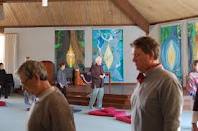
Indoor Walking Meditation
Taken with gratitude from the wonderful UK Order of Interbeing Website
http://interbeing.org.uk/manual/
Kinh Hanh literally means slow walking in Vietnamese. It is the form of walking meditation conducted in the meditation room. We refer to it as Kinh Hanh to distinguish it from Outdoor Walking Meditation. Kinh Hanh is a wonderful meditation which is central to our mindfulness practice.
Usually Kinh Hanh is integrated with sitting meditation practice in the meditation room. Typically it is conducted between two sessions of sitting meditation (eg a period of silent sitting and a guided meditation). This gives a natural break between sessions and also allows us to refresh our body. It offers us the experience of the Sangha moving in mindful unity together in the meditation room.
When we practise Kinh Hanh our breath is coordinated with our steps. When we hear the bell to start we take an in-breath and make one step with the left foot. On the out-breath we take another step with the right foot. Then we begin the cycle again, the left leg always co-ordinated with our in-breath and the right leg always coordinated with our out-breath. Throughout we are continually aware of the body, holding our palms in front of us as a lotus and relaxing the muscles of the mouth in a gentle smile: “Breathing in, I am aware that I am breathing in; breathing out, I smile.” Our body flows in a continuous movement in harmony with our breathing. We are aware especially of the contact of our feet with the ground, and the wondrous nature of the present moment: “Breathing in, I dwell in the present moment;
breathing out, I know it is a wonderful moment.” We hold our head still, focusing our attention about five feet ahead of us, but we are very aware of the Sangha. If we find that we need to slow down or speed up we alter the length of our steps; we do not aim to
change our breathing which stays relaxed and light.
As always the key ingredient in this practice is awareness. Thây once talked of Kinh Hanh as like a book with pages stitched together with a thread of mindfulness. Each step we make is like a page in this book: if we lose our mindfulness at any stage a page is lost from our book. Each step is precious. Another image that is sometimes used is that of lotus footprints. When we walk mindfully it is as though we leave a beautiful golden lotus behind in each footprint. This is a beautiful metaphor for the sacred nature of our contact with the earth as we walk in mindfulness.
Kinh Hanh is best practised in a spirit of celebration and joy. It helps the whole Sangha if we remember to smile.
The sequence of events from sitting meditation to Kinh Hanh back to sitting meditation is generally conducted in silence, co-ordinated with the sound of the bell. This is a very simple process and it is good to remember that all stages are part of the meditation practice. So mindfulness is as important during the ‘change-overs’ as at any other time. The sequence is outlined below:
The period of sitting meditation is brought to an end by the sound of the large bell in the meditation room¨There
then follows a short period when we unfold our legs and rub our feet (if necessary).
¨A sound of the small bell is the signal for us to stand up and arrange our meditation cushions in the centre of the room. This creates a small island of cushions and stools for us to walk around. We then stand in a circle facing inwards (towards each other).
¨When every one is standing and still, a second sound of the small bell signals for us to bow to one another and turn to our left so that we are now in a circle facing clockwise around the room, our left shoulders to the outside walls.
¨On the third sound of the small bell our Kinh Hanh practice begins, as described
above.
¨To end the Kinh Hanh session there will be another sound of the small bell. At this point we do not stop walking. This sound of the bell lets us know that we are on the final circumambulation of the room and should stop by our original place when we reach it.
¨Once everyone has stopped walking and is standing at their original place in the room there is a further sound of the small bell. At this point everyone bows to one another, takes their meditation cushion and resumes their sitting position, ready for the next session of meditation.
The number of circuits of the meditation room during Kinh Hanh will depend on conditions such as the size of room and the time
allotted. Generally one or two circuits is appropriate. In situations where there are many people, it can be helpful to form two or more concentric circles.